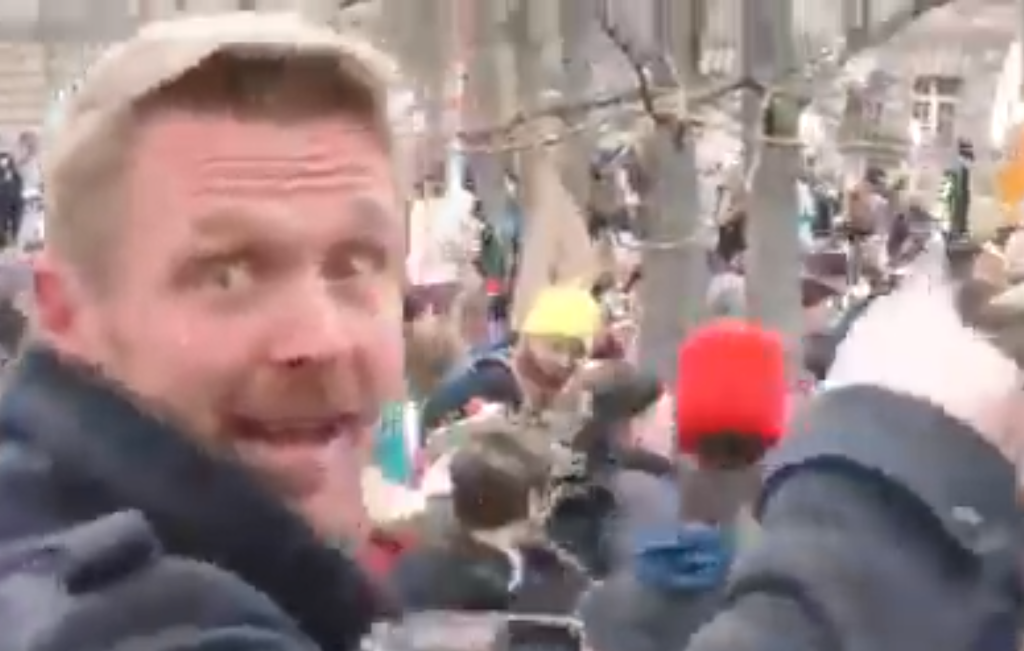The right-wing extremist activist Nikolai Nerling – known as ‘The People’s Teacher’ (‘Der Volkslehrer’) and meanwhile legally barred from the teaching profession – attends a Fridays for Future demo to portray himself as a victim and stir up opinion against the climate protection movement. The video is paradigmatic for attempts by right-wing extremists to denounce political opponents by visiting street protests and to gain attention on social media.

The web video Gretas Lynchmob Hunts VL shows Nerling visiting the Fridays for Future demonstration on 29 March 2019 at the Invalidenpark in Berlin. He had already visited the meeting place a few days earlier to film another video for his YouTube channel, which has been closed down in the meantime, and announced that he wanted to ‘enlighten and inform’ people from there. His followers were called upon to take part in the demonstration with their own ‘climate-sceptical’ messages. Fridays for Future circles had warned about the unwanted visit.
If you watch the whole of the almost 20-minute video of Nerling’s visit to the demonstration, you may not understand why there was so much excitement in advance. It is a compilation of trivial scenes in which Nerling mingles with the demonstrators and comments ironically or disparagingly on the events. The ‘People’s Teacher’, it soon becomes clear, wants to ridicule the protesters rather than document anything. In the style of a satirical report, with a red microphone and acting like an overexcited correspondent, he tries to present demonstrators as blinded and naive, without them being aware of it.
However, it is easy to understand why the organisers opposed him, since Nerling is no stranger to them: The teacher, who worked at a Berlin primary school until his suspension in May 2018, has been convicted of incitement to sedition several times and is considered a cult figure among Holocaust deniers and the anti-government Reichsbürger (‘Reich citizens’) movement. Since his YouTube channel has regularly been blocked, he has been particularly active on bitchute. The platform acts as an alternative to the more strictly regulated YouTube for international right-wing extremism. The video analysed here can also be read against this background of right-wing extremist ‘counter public sphere’. For Nerling is not only trying to mock climate protection activists. As can be seen in the course of the video, his main concern is to weave them into a reactionary narrative of left-wing violence, threats to freedom of expression, and loss of state control.
To achieve this, the video relies on a simple dramatic structure based on scandal: after the cheerful exposition, Nerling intensifies the plot by staging himself as an unwelcome person. The recording of two demonstrators refusing to use his microphone is later subtitled: ‘The first signs of the organizers’ obstruction of my journalistic work are emerging.’ When Nerling is asked to leave the square by a security guard shortly afterwards, he complains to a policeman, who appears to be unimpressed, that he was ‘jostled’ and ‘coerced’. There is no evidence of this in his recordings – but the tone for the rest of the action is set, the roles are cast: The protesters are portrayed as violent enemies of free reporting, Nerling is the alleged victim, and the police are unable or unwilling to protect the freedom of the press.
When a demonstrator tries to wrest the signs from a group of counter-demonstrators standing on the side-lines – the signs show the cover of the right-wing extremist Compact magazine – the action reaches its climax (subtitle: ‘First violent attacks by left-wing extremists…’). The next scene shows the right-wing counter-demonstrators being led off the square by some antifa activists with emphatic shouts of ‘Get lost’, but without physical violence (subtitle: ‘…leading to a hysterical lynch mob-like atmosphere’). When the police excluded Nerling from the rally shortly afterwards because of the unrest his presence was causing, he could barely hide his triumph, posing as the protagonist of a movement: ‘Once again we have proved that free speech is suppressed.’ Nerling thus misuses the role of reporter to twist facts and make biased assertions.
Nerling’s performance can serve as a typical example of right-wing extremist strategies of gaining attention on the social web. Provocation, feigned indignation, and subtle insider-group codes are used to reinterpret what is shown so that it seems to confirm their own world-view. Clumsy assertions and suppositions dominate, which, in conjunction with the style of reportage, are alleged to be evidence and have news value.
The video can be understood as an attempt to gain the approval of an extreme right-wing ‘counter public sphere’ and to turn the real relationship of the participants at the event (around 25,000 climate change protesters against a small number of agitators) into a constructed struggle for power over communication. For this, it is essential that the staged events be confirmed by the participation of others – physically present and online. In conversation with a sympathiser whom he ostensibly met coincidentally (‘followed my call’), Nerling claims towards the end of the video that there were more of his followers on site (he ‘just didn’t see them all…’). In fact, there is a seven-minute livestream of the demonstration on YouTube, in which a user claims to have ‘followed the call of the people’s teacher’ but could not find him. Other videos refer to the ‘scandal’ claimed by Nerling and stir up hatred against ‘climate fascism’, ‘militant anti-fascists’, and Greta Thunberg.
How often the video was actually viewed cannot be said, since YouTube deleted it several times. The available figures, however, suggest that it has mainly been seen within a small, radicalised communication bubble. Although the video, which is unspectacular in itself, cannot be said to have had a broad impact, it is nonetheless an example of a series of similar web video productions with which right-wing extremists (Beatrix von Storch, Lisa Licentia…) provoke attention in the context of democratic street protests. The aggressive way this is used for political purposes points to the danger that right-wing extremist positions may be spread beyond established networks.
Tobias Gralke



